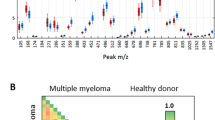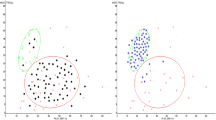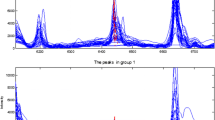Abstract
The discovery of biomarkers unique to multiple myeloma (MM) is of great importance to clinical practice. This study was designed to identify serum tumor marker candidates of MM in the mass range of 700–10000 Da. Serum samples from 48 MM patients and 74 healthy controls were collected and classified into a training dataset (MM/controls: 26/26) and a testing dataset (MM/controls: 22/48). Weak cation exchange magnetic beads, MALDI-TOF MS and analytic software in the CLINPROT system were used to do serum sample pre-fractionation, data acquisition and data analysis. Peak statistics were performed using Welch’s t test. Mass spectra from the two model generation cohorts in the training dataset were analyzed by the Supervised Neural Network Algorithm (SNNA) in ClinProTools(TM) to identify the mass peaks with the highest separation power. The resulting diagnostic model was subsequently validated in the testing dataset. A total of 89 discriminating mass peaks were detected by ClinProTools(TM) in the range of 700–10000 Da using a signal to noise threshold of 3.0. Of these, 49 peaks had statistical significance (P < 0.0001) and four peaks with the highest separation power were picked up by SNNA to form a diagnostic model. This model achieved high sensitivity (86.36 %) and specificity (87.5 %) in the validation in the testing dataset. Using CLINPROT system and MB-WCX we found four novel biomarker candidates. The diagnostic model built by the four peaks achieved high sensitivity and specificity in validation. CLINPROT system is a powerful and reliable tool for clinical proteomic research.



Similar content being viewed by others
References
San Miguel JF, Gutierrez NC, Mateo G, Orfao A. Conventional diagnostics in multiple myeloma. Eur J Cancer. 2006;42:1510–9.
International Myeloma Working Group. Criteria for the classification of monoclonal gammopathies, multiple myeloma and related disorders: a report of the International Myeloma Working Group. Br J Haematol. 2003;121:749–57.
Hussein MA, Juturi JV, Lieberman I. Multiple myeloma: present and future. Curr Opin Oncol. 2002;14:31–5.
Sirohi B, Powles R. Multiple myeloma. Lancet. 2004;363:875–87.
Bataille R, Harousseau JL. Multiple myeloma. N Engl J Med. 1997;336:1657–64.
Hideshima T, Chauhan D, Shima Y, Raje N, Davies FE, et al. Thalidomide and its analogs overcome drug resistance of human multiple myeloma cells to conventional therapy. Blood. 2000;96:2943–50.
Grosbois B, Decaux O, Azais I, Facon T, Avet-Loiseau H. Current treatment strategies for multiple myeloma. Eur J Intern Med. 2002;13:85–95.
Bergsagel PL, Kuehl WM. Molecular pathogenesis and a consequent classification of multiple myeloma. J Clin Oncol. 2005;23:6333–8.
Dingli D, Pacheco JM, Nowakowski GS, Kumar SK, Dispenzieri A, et al. Relationship between depth of response and outcome in multiple myeloma. J Clin Oncol. 2007;25:4933–7.
Kumar SK, Rajkumar SV, Dispenzieri A, Lacy MQ, Hayman SR, et al. Improved survival in multiple myeloma and the impact of novel therapies. Blood. 2008;111:2516–20.
Brenner H, Gondos A, Pulte D. Recent major improvement in long-term survival of younger patients with multiple myeloma. Blood. 2008;111:2521–6.
Cavo M, Terragna C, Renzulli M, Zamagni E, Tosi P, et al. Poor outcome with front-line autologous transplantation in t(4;14) multiple myeloma: low complete remission rate and short duration of remission. J Clin Oncol. 2006;24:e4–5.
Blade J, Rosinol L, Sureda A, Ribera JM, Diaz-Mediavilla J, et al. High-dose therapy intensification compared with continued standard chemotherapy in multiple myeloma patients responding to the initial chemotherapy: long-term results from a prospective randomized trial from the Spanish cooperative group PETHEMA. Blood. 2005;106:3755–9.
Fermand JP, Katsahian S, Divine M, Leblond V, Dreyfus F, et al. High-dose therapy and autologous blood stem-cell transplantation compared with conventional treatment in myeloma patients aged 55 to 65 years: long-term results of a randomized control trial from the Group Myelome-Autogreffe. J Clin Oncol. 2005;23:9227–33.
Wang QT, Li YZ, Liang YF, Hu CJ, Zhai YH, et al. Construction of A Multiple Myeloma Diagnostic Model by Magnetic Bead-Based MALDI-TOF Mass Spectrometry of Serum and Pattern Recognition Software. Anat Rec Adv Integr Anat Evol Biol. 2009;292:604–10.
Baumann S, Ceglarek U, Fiedler GM, Lembcke J, Leichtle A, et al. Standardized approach to proteome profiling of human serum based on magnetic bead separation and matrix-assisted laser desorption/ionization time-of-flight mass spectrometry. Clin Chem. 2005;51:973–80.
Ketterlinus R, Hsieh SY, Teng SH, Lee H, Pusch W. Fishing for biomarkers: analyzing mass spectrometry data with the new ClinProTools software. Biotechniques. 2005;Suppl:37–40.
Villanueva J, Philip J, Entenberg D, Chaparro CA, Tanwar MK, et al. Serum peptide profiling by magnetic particle-assisted, automated sample processing and MALDI-TOF mass spectrometry. Anal Chem. 2004;76:1560–70.
Sogawa K, Satoh M, Kodera Y, Tomonaga T, Iyo M, et al. A search for novel markers of alcohol abuse using magnetic beads and MALDI-TOF/TOF mass spectrometry. Proteomics Clin Appl. 2009;3:821–8.
Ziganshin R, Alekseev DG, Arapidi GP, Ivanov VT, Moshkovskii SA, et al. Serum proteome profiling for ovarion cancer diagnosis using ClinProt magnetic bead technique and MALDI-TOF–mass-spectrometry. Biomed Khim. 2008;54:408–19.
Albitar M, Potts SJ, Giles FJ, O’Brien S, Keating M, et al. Proteomic-based prediction of clinical behavior in adult acute lymphoblastic leukemia. Cancer. 2006;106:1587–94.
Mohamedali A, Guinn BA, Sahu S, Thomas NS, Mufti GJ. Serum profiling reveals distinctive proteomic markers in chronic myeloid leukaemia patients. Br J Haematol. 2009;144:263–5.
Riley RD, Burchill SA, Abrams KR, Heney D, Sutton AJ, et al. A systematic review of molecular and biological markers in tumours of the Ewing’s sarcoma family. Eur J Cancer. 2003;39:19–30.
Duffy MJ. Role of tumor markers in patients with solid cancers: A critical review. Eur J Intern Med. 2007;18:175–84.
Gadducci A, Tana R, Cosio S, Genazzani AR. The serum assay of tumour markers in the prognostic evaluation, treatment monitoring and follow-up of patients with cervical cancer: a review of the literature. Crit Rev Oncol Hematol. 2008;66:10–20.
Bhattacharyya S, Epstein J, Suva LJ. Biomarkers that discriminate multiple myeloma patients with or without skeletal involvement detected using SELDI-TOF mass spectrometry and statistical and machine learning tools. Dis Markers. 2006;22:245–55.
Author information
Authors and Affiliations
Corresponding author
Electronic supplementary material
Below is the link to the electronic supplementary material.
About this article
Cite this article
He, A., Bai, J., Huang, C. et al. Detection of serum tumor markers in multiple myeloma using the CLINPROT system. Int J Hematol 95, 668–674 (2012). https://doi.org/10.1007/s12185-012-1080-3
Received:
Revised:
Accepted:
Published:
Issue Date:
DOI: https://doi.org/10.1007/s12185-012-1080-3




